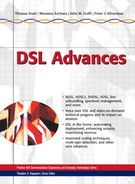3.4. RF Issues
Radio frequency issues were discussed in [1]. However, some new information has emerged with respect to AM radio egress that merits further comment for ADSL. This section also addresses some issues not fully appreciated with early ADSL.
3.4.1. Egress into AM Radio
The egress problem is related to the fringe coverage area of an AM radio station. Some regulators in various countries (for instance, the United Kingdom) have suggested that an AM radio receiver may be as close as 1 m to a telephone line. A radio that close on the fringe area of coverage of an AM radio station can easily be affected by egress of average telephone lines. A radio station could then argue that they should pay less for their radio license because fewer customers are being reached.
A compromise that seems to work is to regulate that a DSL receiver must lower its spectra by 20 dB in the band of any AM radio station that is fringe in the area of the line. Such a radio signal may not be sensed by the DSL line as a noise disturbance. The programmable mask of DMT must be used in such cases to zero tones in the band of the known, fringe AM station. This with the use of Bingham's canceller in [1], for instance, can reduce the spectra by 20 dB and satisfy the objective. It is particularly fortuitous that DMT allows this reduction. An interesting observation is that the highest speeds of what are called SHDSL and also single-carrier-based VDSL do not have any mechanism to implement this reduction in the AM radio band from 560 kHz to 1600 kHz (DMT-based VDSL does have this capability, and does allow symmetric transmission of the same speeds as SHDSL also) or in other bands for other radio signals. In any case, ADSL solves this problem but the operator deploying ADSL must know to preset the modem to zero such bands in a CO neighborhood on the fringe of an AM geographic coverage area.
The performance loss of zeroing one or a few tones is minimal. This particular egress problem was not observed until ADSL was deployed on a wide scale. Fortunately, DMT-based ADSL standards anticipated the general problem and have a provision for it.
3.4.2. Ingress Issue
AM radio ingress usually does not occur on the fringe, but rather close to the radio tower where AM signals are strong enough to couple into phone line at sufficiently high voltages. As in [1], DMT loading will sense the problem and zero the tones in the band of the AM radio signal.
3.4.3. Spectrum above 1.1 MHz
Downstream tones 128 through 256 have images in the band from 1.104 MHz to 1.656 MHz, and thus also overlap the AM transmission band. ADSL line balance at these higher frequencies may be less and thus filtering above 1.104 MHz in the ADSL modem may need to consider AM radio egress. However, the solution afforded by DMT is that again in the fringe area of a radio station, the image frequencies may be zeroed to reduce energy in the band of an AM radio signal anywhere between 1.104 MHz and 1600 kHz. Also, amateur radios in the 1.8 to 2.0 MHz band can alias to frequencies from 200 kHz to 400 kHz, so that often DMT ADSL modems exhibit notches in these low bands.
